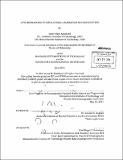| dc.contributor.advisor | Konrad A. Hughen. | en_US |
| dc.contributor.author | Kneeland, Jessie M. (Jessie Mary) | en_US |
| dc.contributor.other | Woods Hole Oceanographic Institution. | en_US |
| dc.date.accessioned | 2012-01-30T16:57:40Z | |
| dc.date.available | 2012-01-30T16:57:40Z | |
| dc.date.copyright | 2011 | en_US |
| dc.date.issued | 2011 | en_US |
| dc.identifier.uri | http://hdl.handle.net/1721.1/68888 | |
| dc.description | Thesis (Ph. D.)--Joint Program in Oceanography/Applied Ocean Science and Engineering (Massachusetts Institute of Technology, Dept. of Earth, Atmospheric, and Planetary Sciences; and the Woods Hole Oceanographic Institution), 2011. | en_US |
| dc.description | Cataloged from PDF version of thesis. | en_US |
| dc.description | Includes bibliographical references. | en_US |
| dc.description.abstract | Corals are increasingly threatened by warming sea surface temperatures and other anthropogenic changes. The delicate symbiosis between corals and their algal endosymbionts (zooxanthellae) is easily disrupted by thermal stress, leading to bleaching and eventual mortality. The use of lipid ratios as biomarkers of environmental conditions is well established. Coral biomass contains abundant lipids, and the potential of lipid parameters to diagnose thermal tolerance in zooxanthellae has been previously suggested. In this thesis, I explore the response of specific fatty acids, sterols, and thylakoid membrane lipids to thermal and disease stress in zooxanthellae grown in culture, as well as those isolated from living corals. I present the discovery of a bioactive thylakoid lipid within zooxanthellae cells, and show how this compound is selectively mobilized in thermally stressed cells. I present a plausible mechanism for the breakdown of this compound into products that may cause apoptosis and disrupt the coral-algal symbiosis, eventually causing bleaching. I present two new lipid biomarkers of thermal stress in zooxanthellae, the C18 fatty acid unsaturation ratio, and the fatty acid to sterol ratio. I calibrate the decline of these two parameters to levels of thermal stress comparable to those needed to cause bleaching. I further show that these parameters are sensitive to pathogen stress as well. In several case studies of diseased and thermally stressed corals, I demonstrate that these lipid biomarkers of coral stress may be applied to zooxanthellae isolated from environmental samples. I show that these same compounds are preserved within coral aragonite, which opens up the potential to retrieve lipid-based historical records of coral health from annual layers of coral skeleton. This work demonstrates the value of using lipid biomarkers to assess coral health and better understand the biochemical mechanisms of coral bleaching. | en_US |
| dc.description.statementofresponsibility | by Jessie Mary Kneeland. | en_US |
| dc.format.extent | 136 p. | en_US |
| dc.language.iso | eng | en_US |
| dc.publisher | Massachusetts Institute of Technology | en_US |
| dc.rights | M.I.T. theses are protected by
copyright. They may be viewed from this source for any purpose, but
reproduction or distribution in any format is prohibited without written
permission. See provided URL for inquiries about permission. | en_US |
| dc.rights.uri | http://dspace.mit.edu/handle/1721.1/7582 | en_US |
| dc.subject | Joint Program in Oceanography/Applied Ocean Science and Engineering. | en_US |
| dc.subject | Earth, Atmospheric, and Planetary Sciences. | en_US |
| dc.subject | Woods Hole Oceanographic Institution. | en_US |
| dc.subject.lcsh | Corals Effect of stress on | en_US |
| dc.subject.lcsh | Zooxanthellate corals | en_US |
| dc.title | Lipid biomarkers of coral stress : calibration and exploration | en_US |
| dc.type | Thesis | en_US |
| dc.description.degree | Ph.D. | en_US |
| dc.contributor.department | Joint Program in Oceanography/Applied Ocean Science and Engineering | en_US |
| dc.contributor.department | Woods Hole Oceanographic Institution | en_US |
| dc.contributor.department | Massachusetts Institute of Technology. Department of Earth, Atmospheric, and Planetary Sciences | |
| dc.identifier.oclc | 773366640 | en_US |
